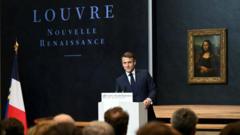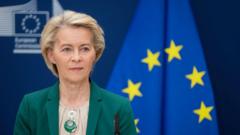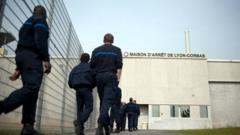**As part of the New Renaissance project, the Mona Lisa will be relocated to a new space, along with significant infrastructure updates set for completion by 2031.**
**Historic Overhaul for the Louvre: Mona Lisa to Get New Home by 2031**

**Historic Overhaul for the Louvre: Mona Lisa to Get New Home by 2031**
**Emmanuel Macron unveils an ambitious renovation plan for the Louvre, aiming to ease overcrowding and enhance visitor experience.**
The world-renowned Mona Lisa will soon be relocating within the Louvre as part of a grand renovation initiative spearheaded by French President Emmanuel Macron. This significant undertaking forms part of what Macron is dubbing the "New Renaissance" project, aimed at transforming the museum to better serve its vast number of visitors while enhancing the display of its cherished collections.
During an event in Paris, Macron announced that the iconic Leonardo da Vinci painting would be moved to a new exhibition area, with plans to implement these changes by the year 2031. The effort arises from concerns over substantial overcrowding, particularly as the Louvre remains the most visited museum globally, attracting around 30,000 visitors each day. The new approach will also involve charging visitors a separate fee to view the Mona Lisa.
Underlining the urgency of the situation, Louvre director Laurence des Cars highlighted the critical need for improvements, stating in a recent letter to the government that the current access point beneath the famous glass Pyramid is "structurally unable to cope" with the influx of over nine million visitors annually. In her correspondence, she pointed out that the overwhelming number of people seeking to catch a glimpse of the painting often have less than a minute to experience it, undermining the values of public service and meaningful engagement with art.
As a part of the comprehensive project, the museum's eastern facade will undergo a redesign, facilitating a new entrance that opens into underground exhibition spaces connected to the iconic pyramid area. Macron emphasized that these enhancements are intended to reintegrate the Louvre into the urban fabric of Paris, including plans for a more open and green esplanade, benefitting both museum-goers and local residents.
The renovation is projected to cost hundreds of millions of euros, but Macron assured that it would not burden taxpayers, as funding sources will include ticket sales, donations, and existing sponsorship agreements.
This latest venture marks a notable pivot for Macron following a reduction in his political power and seeks to build on the attention he garnered during the restoration of Notre-Dame cathedral. His vision aligns with a legacy that echoes the monumental transformations of France's cultural landscape, as he endeavors to ensure the Louvre remains a fitting centerpiece in the heart of Paris.
As adjustments are made, they promise to not only enhance the visitor experience but also invite fresh appreciation for the masterpieces housed within France's illustrious national museum.
During an event in Paris, Macron announced that the iconic Leonardo da Vinci painting would be moved to a new exhibition area, with plans to implement these changes by the year 2031. The effort arises from concerns over substantial overcrowding, particularly as the Louvre remains the most visited museum globally, attracting around 30,000 visitors each day. The new approach will also involve charging visitors a separate fee to view the Mona Lisa.
Underlining the urgency of the situation, Louvre director Laurence des Cars highlighted the critical need for improvements, stating in a recent letter to the government that the current access point beneath the famous glass Pyramid is "structurally unable to cope" with the influx of over nine million visitors annually. In her correspondence, she pointed out that the overwhelming number of people seeking to catch a glimpse of the painting often have less than a minute to experience it, undermining the values of public service and meaningful engagement with art.
As a part of the comprehensive project, the museum's eastern facade will undergo a redesign, facilitating a new entrance that opens into underground exhibition spaces connected to the iconic pyramid area. Macron emphasized that these enhancements are intended to reintegrate the Louvre into the urban fabric of Paris, including plans for a more open and green esplanade, benefitting both museum-goers and local residents.
The renovation is projected to cost hundreds of millions of euros, but Macron assured that it would not burden taxpayers, as funding sources will include ticket sales, donations, and existing sponsorship agreements.
This latest venture marks a notable pivot for Macron following a reduction in his political power and seeks to build on the attention he garnered during the restoration of Notre-Dame cathedral. His vision aligns with a legacy that echoes the monumental transformations of France's cultural landscape, as he endeavors to ensure the Louvre remains a fitting centerpiece in the heart of Paris.
As adjustments are made, they promise to not only enhance the visitor experience but also invite fresh appreciation for the masterpieces housed within France's illustrious national museum.





















